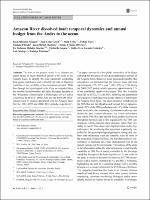Mostrar el registro sencillo del ítem
Amazon River dissolved load: temporal dynamics and annual budget from the Andes to the ocean
| dc.contributor.author | Moquet, J.S. | |
| dc.contributor.author | Guyot, J.L. | |
| dc.contributor.author | Crave, A. | |
| dc.contributor.author | Viers, J. | |
| dc.contributor.author | Filizola, N. | |
| dc.contributor.author | Martinez, J.-M. | |
| dc.contributor.author | Oliveira, T.C. | |
| dc.contributor.author | Sánchez, L.S.H. | |
| dc.contributor.author | Lagane, C. | |
| dc.contributor.author | Lavado-Casimiro, W. | |
| dc.contributor.author | Noriega, L. | |
| dc.contributor.author | Pombosa, R. | |
| dc.date.accessioned | 2019-07-20T03:59:16Z | |
| dc.date.available | 2019-07-20T03:59:16Z | |
| dc.date.issued | 2016-06 | |
| dc.identifier.uri | https://hdl.handle.net/20.500.12542/51 | |
| dc.description.abstract | The aim of the present study is to estimate the export fluxes of major dissolved species at the scale of the Amazon basin, to identify the main parameters controlling their spatial distribution and to identify the role of discharge variability in the variability of the total dissolved solid (TDS) flux through the hydrological cycle. Data are compiled from the monthly hydrochemistry and daily discharge database of the “Programa Climatologico y Hidrologico de la Cuenca Amazonica de Bolivia” (PHICAB) and the HYBAM observatories from 34 stations distributed over the Amazon basin (for the 1983–1992 and 2000–2012 periods, respectively). This paper consists of a first global observation of the fluxes and temporal dynamics of each geomorphological domain of the Amazon basin. Based on mean interannual monthly flux calculations, we estimated that the Amazon basin delivered approximately 272 × 106 t year−1 (263–278) of TDS during the 2003–2012 period, which represents approximately 7 % of the continental inputs to the oceans. This flux is mainly made up by HCO3, Ca and SiO2, reflecting the preferential contributions of carbonate and silicate chemical weathering to the Amazon River Basin. The main tributaries contributing to the TDS flux are the Marañon and Ucayali Rivers (approximately 50 % of the TDS production over 14 % of the Amazon basin area) due to the weathering of carbonates and evaporites drained by their Andean tributaries. An Andes–sedimentary area–shield TDS flux (and specific flux) gradient is observed throughout the basin and is first explained by the TDS concentration contrast between these domains, rather than variability in runoff. This observation highlights that, under tropical context, the weathering flux repartition is primarily controlled by the geomorphological/geological setting and confirms that sedimentary areas are currently active in terms of the production of dissolved load. The log relationships of concentration vs discharge have been characterized over all the studied stations and for all elements. The analysis of the slope of the relationship within the selected contexts reveals that the variability in TDS flux is mainly controlled by the discharge variability throughout the hydrological year. At the outlet of the basin, a clockwise hysteresis is observed for TDS concentration and is mainly controlled by Ca and HCO3 hysteresis, highlighting the need for a sampling strategy with a monthly frequency to accurately determine the TDS fluxes of the basin. The evaporite dissolution flux tends to be constant, whereas dissolved load fluxes released from other sources (silicate weathering, carbonate weathering, biological and/or atmospheric inputs) are mainly driven by variability in discharge. These results suggest that past and further climate variability had or will have a direct impact on the variability of dissolved fluxes in the Amazon. Further studies need to be performed to better understand the processes controlling the dynamics of weathering fluxes and their applicability to present-day concentration–discharge relationships at longer timescales. | es_US |
| dc.format | application/pdf | es_PE |
| dc.language.iso | eng | es_PE |
| dc.publisher | Springer Verlag | es_PE |
| dc.relation.ispartof | urn:issn:0944-1344 | |
| dc.rights | info:eu-repo/semantics/openAccess | es_PE |
| dc.rights | Reconocimiento - No comercial - Sin obra derivada (CC BY-NC-ND) | es_PE |
| dc.rights.uri | https://creativecommons.org/licenses/by-nc-nd/4.0/ | es_PE |
| dc.source | Servicio Nacional de Meteorología e Hidrología del Perú | es_PE |
| dc.source | Repositorio Institucional - SENAMHI | es_PE |
| dc.subject | Amazonia | es_PE |
| dc.subject | Dissolved solid flux | en_US |
| dc.subject | Hydrological variability | en_US |
| dc.subject | Ríos | es_PE |
| dc.subject | Sedimentary Areas | en_US |
| dc.subject | Cuencas | es_PE |
| dc.subject | Weathering | en_US |
| dc.title | Amazon River dissolved load: temporal dynamics and annual budget from the Andes to the ocean | en_US |
| dc.type | info:eu-repo/semantics/article | es_PE |
| dc.identifier.isni | 0000 0001 0746 0446 | |
| dc.description.peerreview | Por pares | es_PE |
| dc.identifier.doi | https://doi.org/10.1007/s11356-015-5503-6 | |
| dc.source.volume | 23 | es_PE |
| dc.source.issue | 12 | es_PE |
| dc.source.initialpage | 11405 | es_PE |
| dc.source.endpage | 11429 | es_PE |
| dc.source.journal | Environmental Science and Pollution Research | es_PE |
| dc.subject.ocde | https://purl.org/pe-repo/ocde/ford#1.05.11 | es_PE |
| dc.subject.sinia | gestion de recursos hidricos de cuenca - Agua | es_PE |
| dc.type.sinia | text/publicacion cientifica | es_PE |
| dc.identifier.url | https://hdl.handle.net/20.500.12542/51 | |
| dc.identifier.url | https://hdl.handle.net/20.500.12542/51 |
Ficheros en el ítem
Este ítem aparece en la(s) siguiente(s) colección(es)
-
Artículo científico [176]








